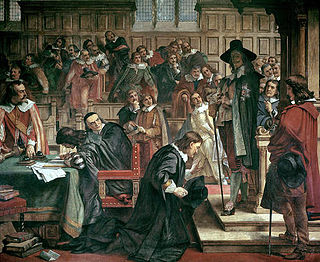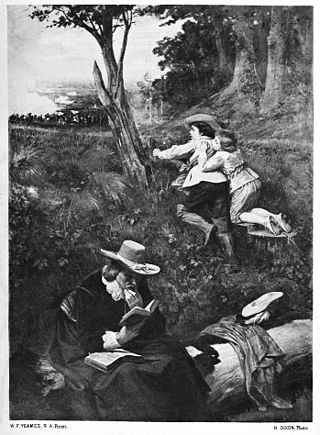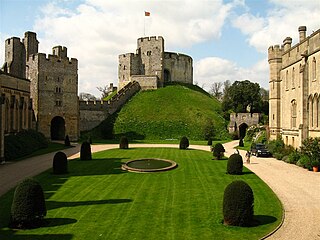
1642 (MDCXLII) was a common year starting on Wednesday of the Gregorian calendar and a common year starting on Saturday of the Julian calendar, the 1642nd year of the Common Era (CE) and Anno Domini (AD) designations, the 642nd year of the 2nd millennium, the 42nd year of the 17th century, and the 3rd year of the 1640s decade. As of the start of 1642, the Gregorian calendar was 10 days ahead of the Julian calendar, which remained in localized use until 1923.

The Battle of Edgehill was a pitched battle of the First English Civil War. It was fought near Edge Hill and Kineton in southern Warwickshire on Sunday, 23 October 1642.

Haywards Heath is a town in West Sussex, England, 36 miles (58 km) south of London, 14 miles (23 km) north of Brighton, 13 miles (21 km) south of Gatwick Airport and 31 miles (50 km) northeast of the county town, Chichester. Nearby towns include Burgess Hill to the southwest, Horsham to the northwest, Crawley northwest and East Grinstead northeast. With only a relatively small number of jobs available in the immediate vicinity, mostly in the agricultural or service sector, many residents work remotely or commute daily via road or rail to London, Brighton, Crawley or Gatwick Airport.

Cuckfield is a village and civil parish in the Mid Sussex District of West Sussex, England, on the southern slopes of the Weald. It lies 34 miles (55 km) south of London, 13 miles (21 km) north of Brighton, and 31 miles (50 km) east northeast of the county town of Chichester. Nearby towns include Haywards Heath to the southeast and Burgess Hill to the south. It is surrounded on the other sides by the parish of Ansty and Staplefield formerly known as Cuckfield Rural.

Mid Sussex is a constituency represented in the House of Commons of the UK Parliament from 2024 by Alison Bennett, a Liberal Democrat.

Sir Michael Livesey, 1st Baronet, also spelt Livesay, was a Puritan activist and Member of Parliament who served in the Parliamentarian army during the Wars of the Three Kingdoms. He was one of the regicides who approved the Execution of Charles I in January 1649.

The Battle of Cheriton of 29 March 1644 was an important Parliamentarian victory during the First English Civil War. Sir William Waller's "Army of the Southern Association" defeated a Royalist force jointly commanded by the Earl of Forth and Sir Ralph Hopton. Defeat ended Royalist hopes of retaking South East England and forced them onto the defensive for the rest of 1644.

St Wilfrid's Church is an Anglican church in the town of Haywards Heath in the district of Mid Sussex, one of seven local government districts in the English county of West Sussex. It is Haywards Heath's parish church, and is the mother church to two of the town's four other Anglican churches. Designed in the Decorated Gothic style by George Frederick Bodley, it was built between 1863 and 1865 as the town began to grow rapidly, and stands in a prominent position on the highest ground in the area. English Heritage has listed it at Grade II* for its architectural and historical importance.
Herbert Morley was an English politician who sat in the House of Commons variously between 1640 and 1667. He fought for the Parliamentary army in the English Civil War. Later he was appointed Lieutenant of the Tower of London.

Sir William Morley, JP was an English politician who sat in the House of Commons at various times between 1626 and 1642. He supported the Royalist cause in the English Civil War.

Sir Edward Ford, was a member of the West Sussex gentry and inventor, who fought for the Royalists in the Wars of the Three Kingdoms. In his "History of the Rebellion", Clarendon judged that while 'a man of honesty and courage', Ford lacked experience of war and was an ineffectual soldier. However, he proved a reliable and trustworthy agent during negotiations between Charles I and Parliament in the period leading up to the 1648 Second English Civil War.

The siege of Chichester was a victory by Parliamentarian forces led by Colonel William Waller over a small Royalist garrison. The siege was one of the key events in the First English Civil War by Waller to secure southern England and declare it for Parliament. The siege lasted five days and ended with surrender by the Royalists. Despite the Royalist surrender, Waller's troops proceeded to sack and desecrate Chichester Cathedral.

The Storming of Farnham Castle occurred on 1 December 1642, during the early stages of the First English Civil War, when a Parliamentarian force attacked the Royalist garrison at Farnham Castle in Surrey. Sir John Denham had taken possession of the castle for the Royalists in mid-November, but after the Royalists had been turned back from London at the Battle of Turnham Green, a Parliamentarian force under the command of Sir William Waller approached the castle. After Denham refused to surrender, Waller's forces successfully stormed the castle. They captured it in under three hours, mostly due to the unwillingness of the Royalist troops to fight. This allowed the Parliamentarians to get close enough to breach the gates, after which the garrison surrendered.

The siege of Arundel took place during the First English Civil War, from 19 December 1643 to 6 January 1644, when a Royalist garrison surrendered to a Parliamentarian army under Sir William Waller.

The Battle of Bramber Bridge was a minor skirmish that took place on 13 December 1643, during the First English Civil War. A Royalist detachment from Arundel attempted to secure the bridge over the River Adur at Bramber in West Sussex, but found a Parliamentarian force already in possession.
The Sussex Militia was an auxiliary military force in Sussex on the South Coast of England. From their formal organisation as Trained Bands in 1572 they defended the coastline, watched the Spanish Armada and took an active part in the English Civil War. It was the Sussex Militia who captured the Duke of Monmouth after his unsuccessful Rebellion in 1685. After a long hiatus, the Sussex Militia was reformed in 1778 and provided internal security and home defence in all of Britain's major wars thereafter. It eventually became the Royal Sussex Light Infantry Militia (RSLIM) and also formed the Royal Sussex Militia Artillery. After the Cardwell Reforms the RSLIM became a battalion of the Royal Sussex Regiment and saw active service in the Second Boer War. It served as a Special Reserve training unit in World War I. After 1921 the militia had only a shadowy existence until its final abolition in 1953.

The Battle of South Harting was a relatively small military engagement that took place on the night of 23–24 November 1643(Jul. Old Style)/3–4 December(Greg. New Style) in the village of South Harting, in West Sussex, England, during Lord Ralph Hopton's Southern Campaign of 1643–1644 during the second year of the First English Civil War.



















